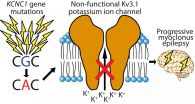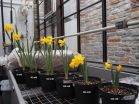Researchers create & control spin waves, lifting prospects for enhanced info processing
2014-11-17
(Press-News.org) A team of New York University and University of Barcelona physicists has developed a method to control the movements occurring within magnetic materials, which are used to store and carry information. The breakthrough could simultaneously bolster information processing while reducing the energy necessary to do so.
Their method, reported in the most recent issue of the journal Nature Nanotechnology, manipulates "spin waves," which are waves that move in magnetic materials. Physically, these spin waves are much like water waves--like those that propagate on the surface of an ocean. However, like electromagnetic waves (i.e., light and radio waves), spin waves can efficiently transfer energy and information from place to place.
The challenge, scientists have found, is developing a means to create and control them.
In the Nature Nanotechnology study, the NYU-UB researchers demonstrated how this could be achieved.
"Spin waves have great potential to improve information processing and make it more energy efficient," says Andrew Kent, a professor in NYU's Department of Physics and the paper's senior author. "Our results show that it's possible to both create and store spin wave energy in remarkably small spaces. The next steps are to understand how far these waves can propagate and how best to encode information in them."
The study's other authors included Ferran Macià, a former NYU-UB Marie-Curie Fellow and now at the University of Barcelona, and Dirk Backes, a former NYU postdoctoral fellow and presently at the University of Cambridge.
Currently, electromagnetic waves in antennas can be converted into spin waves. However, the resulting spin waves have a long wavelength and propagate slowly. By contrast, short-wavelength spin waves can move over greater distances, more quickly, and with less energy, and thus present the possibility of improving a range of communications and electronic devices.
In the Nature Nanotechnology study, the researchers conducted a series of experiments in which they built nanometer scale electrical contacts to inject spin-polarized electrical currents into magnetic materials--a process developed to create and control the movements of its spin waves.
Specifically, by blending different magnetic forces they were able to trap them in a specific area--forming magnetic "droplets" that remained in place rather than propagating, thereby forming a stable energy source. Future research, the scientists say, would then focus on ways to move this localized energy or release it in the form of propagating spin waves.
"We've known that spin waves can propagate, but we've shown in this study that you can control them so they will localize in a specific spot," explains Kent. "By changing the mix of magnetic forces on these droplets--such as with a electrical current or magnetic field--we should be able to get them to emit spin-waves, perhaps as energy bursts, that can encode information."
INFORMATION:
The research was supported by grants from the National Science Foundation (DMR-
1309202) and the Army Research Office (W911NF-08-1-0317) and conducted, in part, at the Center for Functional Nanomaterials, Brookhaven National Laboratory, which is supported by the U.S. Department of Energy. The research was also supported in part by a Marie Curie grant from the European Commission (IOF-253214).
ELSE PRESS RELEASES FROM THIS DATE:
2014-11-17
In what is likely to be a major step forward in the study of influenza, cystic fibrosis and other human diseases, an international research effort has a draft sequence of the ferret genome. The sequence was then used to analyze how the flu and cystic fibrosis affect respiratory tissues at the cellular level.
The National Institute of Allergy and infectious Diseases, of the National Institutes of Health, funded the project that was coordinated by Michael Katze and Xinxia Peng at the University of Washington in Seattle and Federica Di Palma and Jessica Alfoldi at the Broad ...
2014-11-17
LA JOLLA, CA - November 17, 2014 - For decades, scientists thought drug addiction was the result of two separate systems in the brain--the reward system, which was activated when a person used a drug, and the stress system, which kicked in during withdrawal.
Now scientists at The Scripps Research Institute (TSRI) have found that these two systems are actually linked. Their findings, published November 17 in the journal Nature Neuroscience, show that in the core of the brain's reward system are specific neurons that are active both with use of and withdrawal from nicotine. ...
2014-11-17
Joseph B. Muhlestein, M.D., of the Intermountain Medical Center Heart Institute, Murray, Utah, and colleagues examined whether screening patients with diabetes deemed to be at high cardiac risk with coronary computed tomographic angiography (CCTA) would result in a significant longterm reduction in death, heart attack, or hospitalization for unstable angina. The study appears in JAMA and is being released to coincide with its presentation at the American Heart Association's Scientific Sessions 2014.
Diabetes mellitus is the most important coronary artery disease ...
2014-11-17
Yasuo Ikeda, M.D., of Waseda University, Tokyo, Japan, and colleagues examined whether once-daily, low-dose aspirin would reduce the total number of cardiovascular (CV) events (death from CV causes, nonfatal heart attack or stroke) compared with no aspirin in Japanese patients 60 years or older with hypertension, diabetes, or poor cholesterol or triglyceride levels. The study appears in JAMA and is being released to coincide with its presentation at the American Heart Association's Scientific Sessions 2014.
The World Health Organization estimates that annual global mortality ...
2014-11-17
DALLAS - November 17, 2014 - Using next generation gene sequencing techniques, cancer researchers at UT Southwestern Medical Center have identified more than 3,000 new mutations involved in certain kidney cancers, findings that help explain the diversity of cancer behaviors.
"These studies, which were performed in collaboration with Genentech Inc., identify novel therapeutic targets and suggest that predisposition to kidney cancer across species may be explained, at least in part, by the location of tumor suppressor genes with respect to one another in the genome," said ...
2014-11-17
Washington, D.C.--Silicon is the second most-abundant element in the earth's crust. When purified, it takes on a diamond structure, which is essential to modern electronic devices--carbon is to biology as silicon is to technology. A team of Carnegie scientists led by Timothy Strobel has synthesized an entirely new form of silicon, one that promises even greater future applications. Their work is published in Nature Materials.
Although silicon is incredibly common in today's technology, its so-called indirect band gap semiconducting properties prevent it from being ...
2014-11-17
HOUSTON -- (Nov. 17, 2014) - A compound called calcein may act to inhibit topoisomerase IIβ-binding protein 1 (TopBP1), which enhances the growth of tumors, said researchers from Baylor College of Medicine in a report that appears online in the journal Nature Communications.
"The progression of many solid tumors is driven by de-regulation of multiple common pathways," said Dr. Weei-Chin Lin, associate professor of medicine- hematology & oncology, and a member of the NCI-designated Dan L. Duncan Cancer Center at Baylor. Among those are the retinoblastoma (Rb), PI(3)K/Akt ...
2014-11-17
A study led by researchers at University of Helsinki, Finland and Universities of Melbourne and South Australia has identified a new gene for a progressive form of epilepsy. The findings of this international collaborative effort have been published today, 17 November 2014, in Nature Genetics.
Progressive myoclonus epilepsies (PME) are rare, inherited, and usually childhood-onset neurodegenerative diseases whose core symptoms are epileptic seizures and debilitating involuntary muscle twitching (myoclonus). The goal of the international collaborative study was to identify ...
2014-11-17
Scientists have found that altering members of the p53 gene family, known as tumor suppressor genes, causes rapid regression of tumors that are deficient in or totally missing p53. Study results suggest existing diabetes drugs, which impact the same gene-protein pathway, might be effective for cancer treatment.
The University of Texas MD Anderson Cancer Center investigation showed that, in vivo, the genes p63 and p73 can be manipulated to upregulate or increase levels of IAPP, a protein important for the body's ability to metabolize glucose. IAPP is found in some diabetes ...
2014-11-17
BALTIMORE, MD - As the world's diminishing fresh water resources are increasing allocated for human use, agricultural and horticultural production operations must rely more often on the use of brackish, saline, or reclaimed water for irrigation. These saline-rich water sources often contain electrical conductivities that can negativity affect plants' ability to thrive. Salinity is particularly problematic for ornamental plants such as daffodils because of the potential for damage to plants' aesthetics and visual qualities.
In the September 2014 issue of HortScience, Maren ...
LAST 30 PRESS RELEASES:
[Press-News.org] Researchers create & control spin waves, lifting prospects for enhanced info processing




